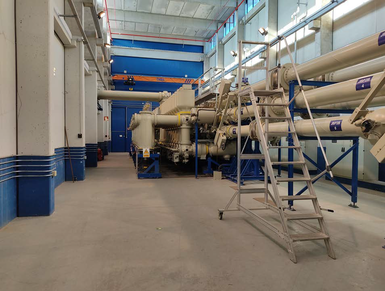Please type a search term (at least two characters)
News
EMPIR project delivers new methodology and standards for ultra-high voltages

The project
Completed European Metrology Programme for Innovation and Research (EMPIR) project Techniques for ultra-high voltage and very fast transients (15NRM02, UHV) worked to support the standardisation of ultra-high voltage measurement techniques, focusing on the needs of three different industrial sectors.
The first of these involved measurements needed for medical x-ray equipment where high voltage direct current pulses are involved in the generation of x-rays used in diagnostic medicine, such as radiology, mammography and dentistry. However, due to the diversity of these types of pulses, until now it has not been possible to establish test procedures for determining the performance of instruments that measure voltages at these levels. The International Electrotechnical Commission (IEC), who produce international standards in the electrical field, have introduced a new measurement quantity named ‘Practical Peak Voltage’. In simple terms this allows a better standardisation with traceability in the calibration of X-ray tubes that deliver doses of radiation to patients. However, prior to this project there was a lack of traceability to the International System of Units, the SI, for these measurements.
Secondly, the project consortium focused on measurements for the electricity network where ultra-high voltage direct current is being introduced to minimise the energy lost as it travels over the grid – currently equivalent to around 150 million tons of CO2 per year. This included measurements of Partial Discharge (PD) in high-voltage power systems.
Finally, the project provided new calibration methods for nanosecond transient sensors used in monitoring and diagnostics of Gas Insulated Systems (GIS), to address the needs of the electrical power industry.
Project achievements
Over the three years that it ran the project’s achievements included developing new measurement methods and artefacts, new or extended Calibration and Measurement Capabilities, as well as providing input to international standards.
The new measurement methods and artefacts are:
- A new recorder, PXIe-5164 oscilloscope, in collaboration with National Instruments, for very fast transient measurements.
- A new method and new CMC’s for RISE and FFII was developed for high voltage traceability of very fast transient overvoltages in testing of instrument transformers for the power grid, demonstrated up to 400 kV and applicable for UHV measurement systems.
- A SI traceable reference system for the measurement of x-ray pulses for voltages up to 150 kV for use in the calibration of x-ray generators and other instrumentation used in clinical diagnostic radiology units.
- A patented Partial Discharge (PD) reference calibrator was developed by FFII which includes a new method for evaluation and qualification of commercial PD measuring systems for high voltage insulation diagnosis. This calibrator is capable of generating trains of PD pulses representing common electrical insulation problems. This instrument is due to be used in the current EMPIR project Metrology for future energy transmission (19ENG02 FutureEnergy).
- A new Gas Insulated System (GIS) testing set-up for very fast transient over-voltages measurements was developed at FFII, to evaluate automatic diagnosis insulation tools that use ultra-high frequency sensors.
As well as new or extended measurement techniques, the project also resulted in has now introduced a CMC, accepted and under review, for the GIS sensor calibration setup for the generation of very fast transient over-voltages.
- New calibration services and procedures for ultra-sensitive Partial Discharge measurements have now been introduced by project partners FFII, RISE, TUBITAK UME and VTT-MIKES.
- FFII, RISE TUBITAK and VTT-MIKES now have CMC for calibration of ultra-sensitive Partial Discharge measurement devices.
- VTT MIKES and RISE now have a CMC for traceability of very fast transient measurements.
- Calibration procedures, including a statement of uncertainty for invasive dividers for different x-ray equipment applications, are now available at LNE.
- FFII, RISE and VTT MIKES have established calibration services for very fast transient sensors up to 400 kV, providing the shortest front time of 6 ns at 100 kV. Further, traceability for transmitted over voltages in voltage instrument transformers is available up to 400 kV and applicable beyond.
Input provided to international standards includes:
- The developed algorithms for improved calibration of x-ray systems is now under consideration for incorporation into IEC 61676.
- Recommendations for type testing of transient recorders have been submitted to the IEC for the revision of IEC 61083-1
- The new methods for Partial Discharge measurements have now fed into the revision of IEC 60270
- Project results have also been used for the revision of IEC 61869-1 standard regarding measurements on instrument transformers.
Alf-Peter Elg of RISE who coordinated this successful project said
“The impact of the project has gone far beyond expectations. The outputs in all disciplines are already in full use and being further exploited in e.g., the ongoing 19ENG02 FutureEnergy for PD in HVDC systems”.
These project results will not only help deliver more accurate x-ray dosing, ensuring the safety of patients and clinicians, but provide grid operators with the tools they require to implement the more efficient energy grids of the future.
This EMPIR project is co-funded by the European Union's Horizon 2020 research and innovation programme and the EMPIR Participating States.
Want to hear more about EURAMET?
Sign up for EURAMET newsletters and other information
Follow us on LinkedIn and Twitter
Carbon dioxide, released from man-made activities, is lowering the pH of the Earth’s oceans, and impacting the health of marine organisms worldwide more
Supporting automated and reconfigurable manufacturing systems more
Working with external project Cool White to test and suggest improvements on the locally available white paints more
The project FutureEnergy has provided new calibration services for ultra-high voltages and a good practice guide on Lightning Impulse dividers more
For many of the 5000 photonics companies in Europe a precise knowledge of a material’s optical properties is vital for industrial competitiveness more





